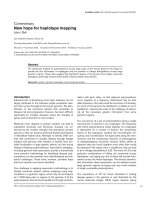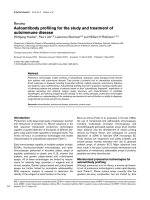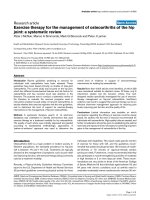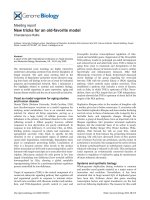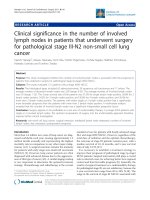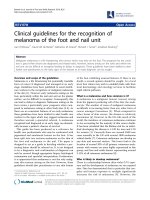Báo cáo y học: "New indications for the use of therapeutic hypothermia" doc
Bạn đang xem bản rút gọn của tài liệu. Xem và tải ngay bản đầy đủ của tài liệu tại đây (29.93 KB, 2 trang )
1
TH = therapeutic hypothermia.
Available online />During the 1950s therapeutic hypothermia (TH) became
widely used for neurological protection during cardiac
surgery, and there were numerous anecdotal reports of the
use of TH in the treatment of neurological injury following
head injury, stroke and anoxic brain injury [1]. For reasons that
are unclear, there were few reports of the use of TH between
1960 and 1992 [2]. Interestingly, at the same time that
intensive care units were developing, the use of TH was
becoming rare. Presumably, intensive care physicians became
sceptical that the unproven benefit of TH was outweighed by
the possibility of adverse effects with this treatment.
In 1991, in a pivotal study conducted in a dog model, Stertz
and coworkers [3] demonstrated that mild TH applied
immediately after resuscitation from prolonged cardiac arrest
significantly improved outcomes. These findings were
confirmed in numerous other animal studies [2]. Given the
poor prognosis with standard treatment of anoxic brain injury
after prolonged out-of-hospital cardiac arrest in adults, it
seemed reasonable to undertake clinical trials of TH in this
condition. However, at that time, most intensive care
physicians regarded hypothermia as quite hazardous, leading
inevitably to cardiac arrhythmias, sepsis, coagulopathy and
electrolyte abnormalities. Therefore, few centres appeared to
be interested in this novel treatment.
In contrast, our intensive care unit was using TH in selected
patients with severe traumatic brain injury, and we found this
treatment to be associated with minimal adverse effects [4].
Largely because of this experience, our ethics committee
approved preliminary clinical studies of TH in adults who
were comatose after resuscitation from out-of-hospital
cardiac arrest. Subsequently, we cooled 22 patients to
33°C for 12 hours and compared their outcomes with those
of the previous 22 cardiac arrest patients who had been
maintained at normothermia [5]. Our results were sufficiently
supportive that we proceeded to conduct a randomized,
controlled trial. Both our study [6] and a European study [7]
found that TH improved outcomes after out-of-hospital
cardiac arrest, where the initial cardiac rhythm was
ventricular fibrillation. In 2003, the International Liaison
Committee on Resuscitation [8] recommended treatment
with TH in such patients.
Should TH be used in patients with neurological injury
outside this indication? In a recent issue of Critical Care,
Hartemink and coworkers [9] described three case reports in
which TH was used as part of the treatment for unusual
neurological injuries, including focal brain injury due to
vascular disruption, spinal cord injury and global anoxic injury
following asphyxial cardiac arrest. In these conditions, any
Commentary
New indications for the use of therapeutic hypothermia
Stephen Bernard
The Intensive Care Unit, Dandenong Hospital, Melbourne, Australia
Correspondence: Stephen Bernard,
Published online: 4 November 2004 Critical Care 2004, 8:E1 (DOI 10.1186/cc2994)
This article is online at />© 2004 BioMed Central Ltd
Related to Research by Hartemink et al., see Issue 8.5, page 395
Abstract
Randomised, controlled trials of therapeutic hypothermia have demonstrated improved outcomes after
out-of-hospital cardiac arrest, where the initial cardiac rhythm was ventricular fibrillation. This therapy is
now endorsed by the International Liaison Committee on Resuscitation. The role of therapeutic
hypothermia in patients with anoxic neurological injury due to stroke, spinal cord injury or asphyxial
cardiac arrest is uncertain. However, given the strong theoretical benefit and the minimal adverse side-
effects, it is reasonable for clinicians to consider the use of therapeutic hypothermia in such cases.
Keywords cerebral, hypothermia, induced, injury, spinal
2
Critical Care December 2004 Vol 8 No 6 Bernard
benefit from TH is unproven. Is it therefore reasonable to use
TH in such patients outside the context of a clinical trial?
To answer this question, both the theoretical benefits and
possible adverse effects of TH must be carefully considered.
Clearly, there are considerable theoretical benefits from TH in
the three conditions described. In particular, laboratory data
for the use of TH in stroke, spinal cord injury and asphyxial
cardiac arrest is very supportive of benefit of TH in animal
models of these injuries [10,11].
Fortunately, there is now also extensive clinical data that
suggest that TH carries a very low risk for adverse side
effects in adults in a modern intensive care unit. For example,
in our studies of patients with severe head injury and anoxic
brain injury after out-of-hospital cardiac arrest, we have rarely
seen complications such as cardiac arrhythmias, sepsis or
coagulopathy [4,5,12]. In addition, there are minimal logistic
and cost issues.
Finally, it is highly unlikely that randomized controlled trials
could be conducted in patients with the types of injuries
described in the report by Hartemink and coworkers [9].
Such injuries in any one city are very rare, and controlled
trials would need to enrol large numbers of patients to have
sufficient power to demonstrate benefit.
Therefore, given that there is a sound scientific basis and
likelihood of benefit, a proven low incidence of adverse events
and a high morbidity or mortality rate with the injury, the use of
TH seems well justified in the types of cases presented.
Intensive care physicians are therefore encouraged to
consider the use of TH in similar cases in the future.
Competing interests
The author(s) declare that they have no competing interests.
References
1. Vandam DV, Burnap TK: Hypothermia. N Engl J Med 1959, 261:
546-553.
2. Bernard SA: Induced hypothermia in intensive care medicine:
a review. Anaesth Intensive Care 1996, 24:382-388.
3. Sterz F, Safar P, Tisherman S, Radovsky A, Kuboyama K, Oku K:
Mild hypothermic cardiopulmonary resuscitation improves
outcome after cardiac arrest in dogs. Crit Care Med 1991, 19:
379-389.
4. Bernard SA, Jones BM, Buist M: Experience with prolonged
induced hypothermia in patients with severe head injury. Crit
Care 1999, 3:167-172.
5. Bernard SA, Jones BM, Horne MK: A clinical trial of induced
hypothermia in comatose survivors of prehospital cardiac
arrest. Ann Emerg Med 1997, 30:146-153.
6. Bernard SA, Gray TW, Buist MD, Jones BM, Silvester W, Gut-
teridge G, Smith K: Treatment of comatose survivors of out-of-
hospital cardiac arrest with induced hypothermia. N Engl J
Med 2002, 346:557-563.
7. Hypothermia after Cardiac Arrest Study Group: Mild therapeutic
hypothermia to improve the neurologic outcome after cardiac
arrest. N Engl J Med 2002, 346:549-556.
8. Nolan JP, Morley PT, Hoek TL, Hickey RW; Advancement Life
support Task Force of the International Liaison committee on
Resuscitation: Therapeutic hypothermia after cardiac arrest.
An advisory statement by the Advancement Life Support Task
Force of the International Liaison Committee on Resuscita-
tion. Resuscitation 2003, 57:231-235.
9. Hartemink KJ, Wisselink W, Rauwerda JA, Girges ARJ, Polderman
KH: Novel applications of therapeutic hypothermia: report of
three cases. Crit Care 2004, 8:R336-R342.
10. Bernard SA, Buist MD: Induced hypothermia in the intensive
care unit: a review. Crit Care Med 2003, 31:2041-2051.
11. Katz LM, Young A, Frank JE, Wang Y, Park K: Neurotensin-
induced hypothermia improves neurologic outcome after
hypoxic-ischemia. Crit Care Med 2004, 32:806-810.
12. Bernard SA, Buist MD, Monteiro O, Smith K: Induced hypother-
mia using large volume, ice-cold intravenous fluid in
comatose survivors of out-of-hospital cardiac arrest: a prelim-
inary report. Resuscitation 2003, 56:9-13.



